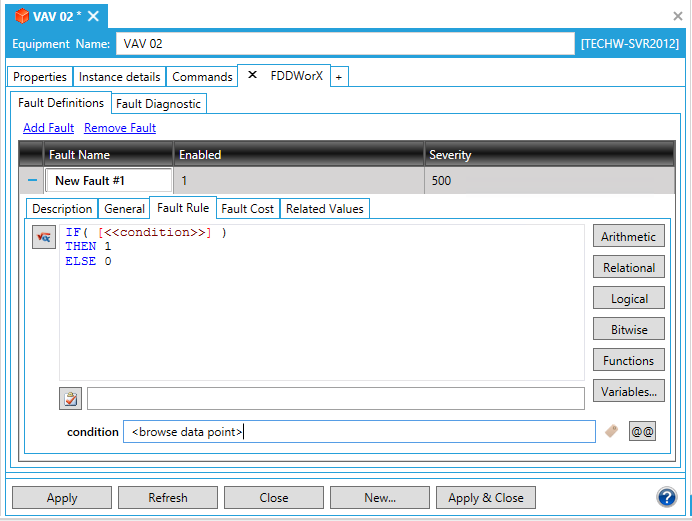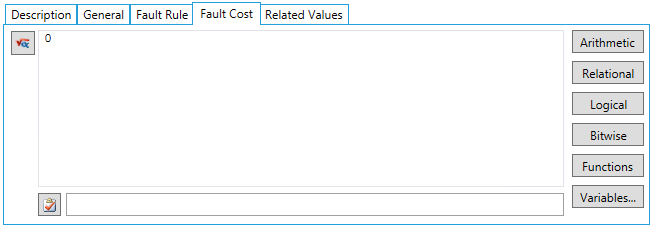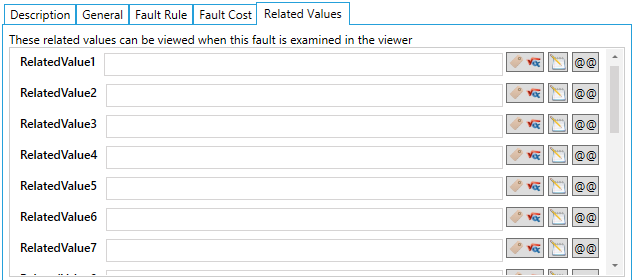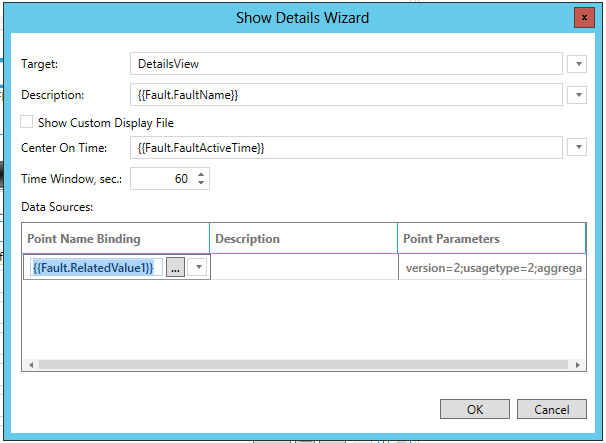|
|
The features on this page require an add-on to work with GENESIS64 Basic SCADA. |
|
|
The features on this page require an add-on to work with GENESIS64 Basic SCADA. |
Once you have added the FDDWorX tab to the asset's Equipment form in the AssetWorX provider in Workbench, you'll be able to add (and then eventually select) from a list of added Faults.
|
|
Note: This tab is also available for equipment classes. All equipment classes are defined, within AssetWorX, in the Equipment Classes node. In AssetWorX, you can define and use equipment classes as templates for creating nodes in the asset tree. You can also use aliases in your equipment classes; these aliases will prompt you for actual properties of equipment as you use the equipment classes to define nodes in the asset tree. For more information, refer to the Introduction to Equipment Classes (Templates) and Creating Equipment Classes for Use as Templates topics. |
To Set a Fault:
The Fault Definitions tab will be open by default. Click on Add Fault. You'll see a single fault section appear. At any point, if you click on Add Fault again, it will add a second fault beneath the first, then a third, etc. You can remove any individual fault by first selecting it, then clicking Remove Fault.
In a newly added fault, in the Fault Name field, enter a name for the fault.
|
|
Note: The fault name can be any description attributed to any state of operation for the asset to which the user wishes to be alerted. It does not necessarily have to correlate to specific alarms or conditions. |
You may need to click on the fault name again in order to further edit the fault's details, as shown below:
The Fault Definitions tab contains five sub-tabs: Description, General , Fault Rule, Fault Cost and Related Values.
In the Description subtab, shown below, you can enter a description in the text entry field to help differentiate each individual fault.
Description Subtab

The General subtab reflects the settings in the top columns. You can edit the settings for Enabled and/or Severity. Clicking the  button to the right of either of the text entry fields opens the Configure the expression window, allowing you to use the majority of Expression Editor options (Arithmetic, Relational, Logical, Bitwise, Functions). The Check Syntax button [
button to the right of either of the text entry fields opens the Configure the expression window, allowing you to use the majority of Expression Editor options (Arithmetic, Relational, Logical, Bitwise, Functions). The Check Syntax button [ ] helps to make sure you have constructed your expression correctly. Any related error/suggestions will appear in the nearby text entry field.
] helps to make sure you have constructed your expression correctly. Any related error/suggestions will appear in the nearby text entry field.
General Subtab

The Fault Rule subtab settings allow you to use the ICONICS Expression Editor (with options for Arithmetic, Relational, Logical, Bitwise, Functions or Variables in your expression) to enter the rule to associate with the fault. You have the option of creating a new rule, editing an existing rule, importing a rule, or setting additional rule parameters. If you would like more screen space to type a complex fault rule expression, you can select the Pop Up Fault Rules Editor button [ ] to open a pop-up window with an expanded fault rule editing area. Any changes that you make to the fault rule expression in the pop-up window are reflected in the original Fault Definitions Tab, and vice versa.
] to open a pop-up window with an expanded fault rule editing area. Any changes that you make to the fault rule expression in the pop-up window are reflected in the original Fault Definitions Tab, and vice versa.
Fault Definitions Tab - Fault Rule Subtab

Clicking on the Variables button opens the Data Browser, allowing you to search for the data source related to your Fault.
You can then set the Fault Rule's parameters vis the context-sensitive text entry field. Some selections within the Fault Rule will activate certain options in the parameters section in order to set related options.
Click on the Check Syntax button [ ] to make sure you have constructed your fault rule correctly. Any related error/suggestions will appear in the nearby text entry field.
] to make sure you have constructed your fault rule correctly. Any related error/suggestions will appear in the nearby text entry field.
You can also set a condition in the bottom text entry field by clicking on the  button, which launches the Data Browser, allowing you to navigate to a data point to set your condition. Clicking on the
button, which launches the Data Browser, allowing you to navigate to a data point to set your condition. Clicking on the  button opens the Alias selection for 'condition' parameter window, shown below. Use the Alias Name pulldown menu to select the alias, and then the Property Name pulldown menu to select the associated property. Click on the
button opens the Alias selection for 'condition' parameter window, shown below. Use the Alias Name pulldown menu to select the alias, and then the Property Name pulldown menu to select the associated property. Click on the  button to refresh the list of available properties for the selected alias. Click OK to return to the Fault Rule subtab.
button to refresh the list of available properties for the selected alias. Click OK to return to the Fault Rule subtab.

Once you have finished adding Fault Rules, click Apply to save your settings.
In the Fault Cost subtab, shown below, you can enter the cost to associate with the fault. You have the option of creating a new cost, editing an existing cost, importing a cost, or setting additional cost parameters.
Fault Cost Subtab

If you would like more screen space to type a complex fault cost expression, you can select the Pop Up Cost Rules Editor button [ ] to open a pop-up window with an expanded fault cost editing area. Any changes that you make to the fault cost expression in the pop-up window are reflected in the original Fault Definitions Tab, and vice versa.
] to open a pop-up window with an expanded fault cost editing area. Any changes that you make to the fault cost expression in the pop-up window are reflected in the original Fault Definitions Tab, and vice versa.
Similar to the Expression Editor, the Cost Editor allows you to use Arithmetic, Relational, Logical or Bitwise expressions, as well as Functions or Variables. Clicking on the Variables button opens the Data Browser, allowing you to search for the data source related to your Fault.
You can then set the Fault Cost's parameters vis the context-sensitive text entry field. Some selections within the Fault Cost will activate certain options in the parameters section in order to set related options.
Click on the Check Syntax button [ ] to make sure you have constructed your fault cost correctly. Any related error/suggestions will appear in the nearby text entry field.
] to make sure you have constructed your fault cost correctly. Any related error/suggestions will appear in the nearby text entry field.
Once you have finished adding a Fault Cost, click Apply to save your settings.
In the Related Values subtab, shown below, for each Related Value (or FaultCost) that you wish to create, either type in a static value in the provided text box or click on the  button to browse for a data point OR an expression (see the tabs in the top right of the Data Browser window). You can add up to 20 values that you wish to capture as part of the fault whenever the fault condition occurs. You can view these related values when you examine faults in the FDDWorX Viewer.
button to browse for a data point OR an expression (see the tabs in the top right of the Data Browser window). You can add up to 20 values that you wish to capture as part of the fault whenever the fault condition occurs. You can view these related values when you examine faults in the FDDWorX Viewer.
Related Values Subtab

Clicking the  button opens the Show Details Wizard, shown below.
button opens the Show Details Wizard, shown below.
Show Details Wizard

Target - Enter a target in the text entry field or click on the  button to use the pulldown menu.
button to use the pulldown menu.
Description - Enter a description in the text entry field or click on the  button to use the pulldown menu.
button to use the pulldown menu.
Show Custom Display File - Click this checkbox to show a custom display file. Once checked, you will activate the Custom Display and Target Type settings.
Custom Display - Enter the location of the custom display or click on the  button to use the pulldown menu.
button to use the pulldown menu.
Target Type - Use the pulldown menu to select from either Current, Popup or PopupModal.
Center On Time - Enter a time or or click on the  button to use the pulldown menu.
button to use the pulldown menu.
Time Window, sec. - Enter a time window in seconds.
Data Sources - In this section, you can add a Point Name Binding via text entry; ellipsis button [...], which opens the Data Browser, or by clicking on the  button to use the pulldown menu. You can also enter a Description, via the text entry field within the cell, and Point Parameters, which should be filled by default but can also be edited within the text entry field.
button to use the pulldown menu. You can also enter a Description, via the text entry field within the cell, and Point Parameters, which should be filled by default but can also be edited within the text entry field.
Click OK to close the Show Details Wizard and return to the Related Values subtab.
Clicking on the  button opens the Alias selection for 'RelatedValueX' parameter window, shown below. Use the Alias Name pulldown menu to select the alias, and then the Property Name pulldown menu to select the associated property. Click on the
button opens the Alias selection for 'RelatedValueX' parameter window, shown below. Use the Alias Name pulldown menu to select the alias, and then the Property Name pulldown menu to select the associated property. Click on the  button to refresh the list of available properties for the selected alias. Click OK to return to the Related Values subtab.
button to refresh the list of available properties for the selected alias. Click OK to return to the Related Values subtab.

In order to save the changed status of the Fault Definitions Tab, you must either click on the Apply button at the bottom of the tab window within the Project Explorer (and can then proceed to make additional changes to the same Fault Definition) OR click on Apply & Close to save your settings and then return to the main Project Explorer by closing the tab OR click on Refresh to update the Fault Definitions tab itself OR click on Reset to return the state of the Fault Definitions tab to the last saved settings OR click on Apply & New to save the current settings while creating a new fault definition OR click on Add New... to change the settings for an additional asset.
See Also
Add a FDDWorX Diagnostic Model to a Selected Asset
Using Diagnostic Matrices in the AssetWorX Provider